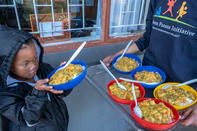Social Grants for the Impoverished
Usually the most vulnerable in a city-dwelling community are the disabled, the elderly and children. And for those who have no breadwinner in the home bringing in some kind of income, society needs to step in to help.

There are a number of different strategies being used in various poorer countries, ‘including direct feeding programmes, social assistance, urban agriculture, public works, and food price controls’, writes Daniel Warshawsky, a geographer at the University of South California and author of a report on the advent of food banking in southern Africa.
These can be implemented by various types of institutions, from ‘multiple levels of government, non-governmental organisations, community based organisations, and private sector businesses’. Social grants for women appear to be particularly important in addressing concerns on food insecurity, since it is about income, poverty and access to the right foods.
The work of Professor Dori Posel of the University of KwaZulu-Natal’s School of Development Studies indicates that social grants made a difference in terms of alleviating the depth and severity of poverty for women in the late 2000s. ‘Social income grants do appear to have decreased the “extent, depth and severity” of poverty in women-headed households,’ she says. Policy makers might bear this in mind.
Food Vouchers and Feeding Schemes
Meanwhile, Hein Marais, in his book South Africa Pushed to the Limit: The Political Economy of Change, suggests that a universal income grant is a much better way of addressing development, boosting well-being and emancipating workers.
Some useful models for supporting food insecure groups, according to Warshawsky, include food-for-work programmes, food stamps and various feeding schemes rolled out through schools, crèches, shelters and soup kitchens.
Another relatively successful model is food banking, where leftover but still good food from the retail sector, for instance, is diverted from the retail chain and into distribution networks such as soup kitchens or shelters that deliver it to people in need. Vouchers, food stamps and similar models are also ways of assisting the most vulnerable.
Feeding Schemes at the Mercy of Government

So far, the state has not been proactive enough in addressing micronutrient deficiencies in spite of the significant cost to the economy of raising generation after generation of cerebrally underdeveloped children. In addition, the private sector needs to ‘get more involved in finding sustainable solutions’.
Many feeding schemes are not sustainable because they are at the mercy of public funding being available and allocated to this cause. If tax revenues decline or policy priorities shift, many feeding schemes for schoolchildren or voucher systems for the poor get abandoned.
And even when school feeding schemes are installed, often those responsible for implementing the schemes are only concerned with quantities of food – the number of calories or volume of mealie meal served – and not the quality.
Restrictions on Marketing Practices
But if you can tackle the supply side, for instance by reducing salt and sugar, and achieve healthier foods from the production lines, that would be a good start.
South African health minister Aaron Motsoaledi reflected contemporary thinking in many developed world countries by suggesting that there should be some kind of restrictions placed on marketing practices of the food sector, particularly targeting children. It might also help if the consumer were encouraged to make different choices when the hunger pangs kick in.
What would work better: to drive down the demand for Happy Meals by educating people not to buy this kind of food, thereby forcing the food producer to change its menu; or legislating for the removal of all toys from Happy Meals? ‘I’m not sure what would work better,’ admits Stephan Engels from the Global Alliance for Improved Nutrition (GAIN).
‘Maybe both?’ Thinking from the health sector suggests that the food and beverage producers have been left to their own devices for too long now, and that we cannot only hope that individual choices and behaviour change will do the trick.
By Leonie Joubert